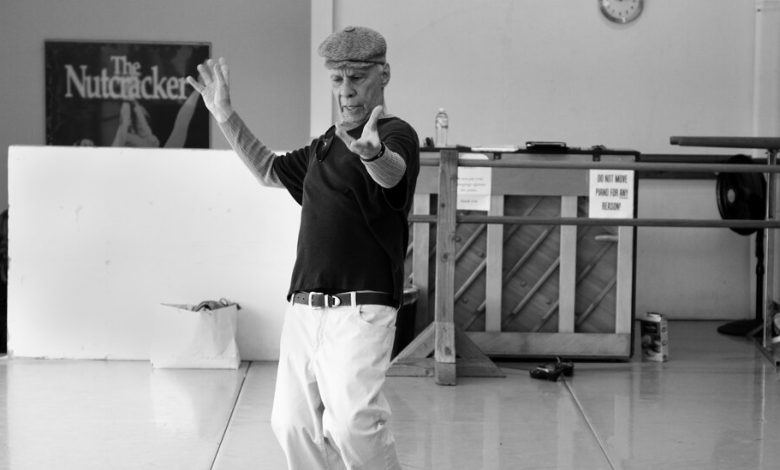Rudy Perez, a Pioneer of Postmodern Dance, Is Dead at 93

Rudy Perez, a minimalist choreographer who was a pioneer of postmodern dance, a movement that upended notions of what dance might look like, died on Sept. 29 at his home in Los Angeles. He was 93.
The cause was complications of asthma, said Sarah Swenson, a friend and fellow choreographer who was a member of Mr. Perez’s ensemble.
In the early 1960s, Mr. Perez was among a cohort of avant-garde artists who blurred the lines of their disciplines and employed all sorts of quotidian and often absurdist actions in their work. Performance art and conceptual art, experimental theater, music and dance seemed all of a piece, their practitioners united in challenging established traditions. Many of them were members of Judson Dance Theater, an experimental collective in Greenwich Village.
The collective was short-lived — it began in the fall of 1962 and lasted only a few years — but it was influential. Performances were typically bare-bones, held in a church on the south side of Washington Square Park, and admission was free. There, Carol Schneeman staged her food fight, otherwise known as “Meat Joy,” with half-dressed dancers rolling about in raw chickens, wet paint and scraps of this and that. Lucinda Childs enveloped herself in a stretchy tube of fabric and transformed it into what looked, variously, like a bathtub, a boat and a crib. And Mr. Perez performed his duet “Take Your Alligator With You,” a spoof of the tropes of fashion photography enacted in a series of campy poses.
Mr. Perez later carried the Judson spirit with him, in pieces that defied categories and narratives. In “Bang Bang,” a piece he staged in 1966, he stalked the stage, dressed in coveralls and work goggles and brandishing a large pole, while the sound of an episode of Julia Child’s cooking show devoted to asparagus was heard in the background; you could hear Ms. Child’s high, piping voice declaiming the delights of that vegetable.
That same year, Mr. Perez performed what would become one of his best-known works, “Countdown,” in which he sat majestically on a stool smoking a cigarette, his face impassive but streaked with paint, as a recording of French folk songs played.
Don McDonagh, writing in The New York Times in 1968, called the piece a “dreamy work of meditative intensity” that showed a man “brought out of himself by a few French songs.” “In all his works,” he added, “Mr. Perez moves like a graceful strongman.”
But was it dance? Like that of his colleagues, Mr. Perez’s work was confounding because it had so little conventional movement in it, as Lewis Segal, the longtime dance critic for The Los Angeles Times, said in a documentary about Mr. Perez. Because of Mr. Perez and others, Mr. Segal said, “Now you can pretty much accept that you can have any kind of movement be dance if a dance intelligence and a dance artistry shapes it.”
Mr. Perez was known for his spare choreography, but he sometimes veered into zany maximalism. For a piece he staged in 1972 in a parking lot at Connecticut College in New London as part of a dance festival for the college’s 25th-anniversary celebration, a bicycle, six cars and two motorcycles careened around a hapless, ineffectual traffic cop. Writing in The New York Times, Mr. McDonagh called it “an elaborate ballet of evasion.”
“Coverage,” first performed in 1970, was one of Mr. Perez’s best-loved works, and it became a touchstone for generations of dancers. In that piece, a man dressed in white coveralls and a blue hard hat confines himself within a square of red tape that he carefully lays out on the stage. Inside its parameters, he slips off his uniform and leaps about — one moment a basketball player, another a Bob Fosse dancer — to snippets of pop music, news reports, the sound of keening bagpipes and, in conclusion, “God Bless America.” It seemed like an elegy of sorts to the plight of the modern American male, caught between conformity and individualism. Or maybe not.
“He liked to leave things open,” Anne Grimaldo, who was a member of Mr. Perez’s company for 35 years, said in a phone interview. “He never spoon-fed the audience.”
By 1978, Mr. Perez had moved to Los Angeles to teach at the University of California. He was hired for a year but stayed in Los Angeles after that, having fallen in love with the city’s open vistas and the potential, as Deborah Vankin of The Los Angeles Times wrote in 2015, to stretch out his work in site-specific spaces. There, he formed his own company and became part of a vibrant dance scene. (He also learned to drive at age 49.)
“There were so many wonderful spaces to do outdoor pieces — streets, office buildings, courtyards, that weren’t being used,” he told Ms. Vankin. “In L.A., I felt freer, I was able to go beyond. I wanted to get away from the emphasis on dance and work more with theater and natural movement.”
He was, Mr. Segal of The Los Angeles Times said by phone, “like an abstract expressionist,” adding: “His pieces were very emotional and very dramatic without telling a story. They were dreams without a plot or characters.”
Mr. Perez was always reluctant to interpret his own work for others. When Ms. Vankin visited his studio in 2015 and asked him to explain a new piece he was staging, he told her, “It’s very much how I feel about what’s going on in the world.”
Which is what, exactly? Ms. Vankin asked.
“I’m not gonna say. I’m very abstract. Once it becomes narrative, it’s all over. Let the audience decide what it’s about.”
Rudolph Anthony Perez was born on Nov. 24, 1929, in Manhattan and grew up in the Bronx and East Harlem. His mother, Maria Rivera, was a homemaker. He was adopted by his stepfather, Albino Perez, a merchant mariner.
His mother died of tuberculosis when Rudy was 7; he was also stricken by the disease and spent the next three years mostly bedridden in various hospitals, an experience that instilled in him a sense of always being an outsider.
When he was a little older, he began dancing the samba and the cha-cha at family gatherings. “I didn’t set out to be a dancer,” he told an interviewer in 2020, “it was just a hobby at the time.” He added, “Because I was a very good social dancer, as a young person, as a Latino, you got me on the dance floor and you couldn’t get me off.”
He took piano and voice at the High School of Music & Art in Manhattan (now the Fiorello H. LaGuardia School of Music & Art and Performing Arts) before turning to dance, which he studied at the New Dance Group, an early modern dance collective and school, in 1951. He later studied with Martha Graham and Merce Cunningham.
In a class with Cunningham, he met Elaine Summers, a member of the Judson collective, who invited him to perform with her. Yet even then dance was still a hobby for him; it was therapy, he told The New York Times in 2019. He had day jobs as a messenger, a computer operator, an usher, a waiter and a stock boy at Bloomingdale’s. He also worked at Bellevue Hospital with the movement therapist Marian Chace.
Mr. Perez is survived by a brother, Richard, and his longtime partner, James P. Kovacs.
Mr. Perez created some 100 dances during his long career and taught for more than half a century, even after his sight dimmed from glaucoma and macular degeneration. In 2018, the choreographer Jeff Slayton asked him which ones were his favorites.
“I really enjoyed doing my solos,” Mr. Perez said — the ones, he added, “where I could just be a guy and maybe poke fun at dance. That I loved.”





